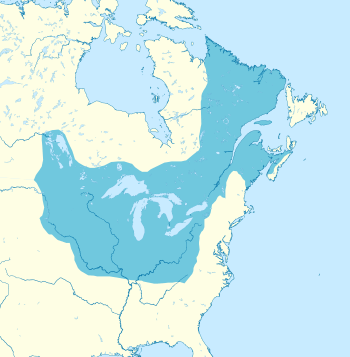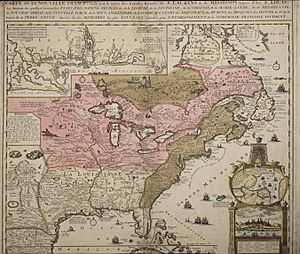Canada (New France) facts for kids
Quick facts for kids
Canada
|
|||||||||
|---|---|---|---|---|---|---|---|---|---|
| 1535–1763 | |||||||||
|
The Royal Banner of early modern France or "Bourbon Flag" was the most commonly used flag in New France
The lesser coat of arms of France
as used by the Government |
|||||||||

Map of Canada after 1713. At its fullest extent, Canada extended from south of the Great Lakes to the Gulf of St Lawrence.
|
|||||||||
| Status | Colony of France within New France | ||||||||
| Capital | Quebec | ||||||||
| Common languages | French | ||||||||
| Religion | Roman Catholicism | ||||||||
| Government | Monarchy | ||||||||
| King | |||||||||
| Governor | |||||||||
| History | |||||||||
|
• French territorial possession
|
1535 | ||||||||
|
• Founding of Quebec
|
1608 | ||||||||
|
• Founding of Trois-Rivières
|
1634 | ||||||||
|
• Founding of Montreal
|
1642 | ||||||||
| 1763 | |||||||||
| Currency | New France livre | ||||||||
| ISO 3166 code | CA | ||||||||
|
|||||||||
| Today part of | |||||||||
The colony of Canada was a French colony that was part of a larger area called New France. France claimed this land in 1535 during the second trip of Jacques Cartier. He claimed it for the French king, King Francis I. Canada stayed a French territory until 1763. At that time, it became a British colony known as the Province of Quebec.
In the 1500s, the word "Canada" meant the land along the Saint Lawrence River. This area stretched from Grosse Isle to a spot between Québec and Trois-Rivières. Sometimes, "Canada" and "New France" were used to mean the same thing. French explorers kept going west into areas like Hochelaga and Saguenay before any towns were built. In 1600, a permanent trading post was set up at Tadoussac. This was where the Saguenay and Saint Lawrence rivers meet. However, it was only for trade, so it wasn't an official French settlement.
The first official French settlement in Canada was Québec, founded by Samuel de Champlain in 1608. New France had four other colonies: Hudson's Bay to the north, Acadia and Newfoundland to the east, and Louisiana far to the south. Canada was the most developed of these five colonies. It was divided into three main areas: Québec, Trois-Rivières, and Montreal. Each area had its own government. The governor of the Québec area was also the main governor for all of New France.
The Seven Years' War was a big conflict where Great Britain defeated France and its allies. As a result, Britain took control of Canada. In the Treaty of Paris of 1763, which officially ended the war, France gave Canada to Britain. In return, France received other colonies. A large part of Canada then became the British colony of the Province of Quebec.
Contents
Territorial Growth
Between 1524 and 1763, the French made many changes to North America. They divided and cleared land, built villages and towns, and created roads. They also built various structures. French colonists changed the land to fit their needs.
Canada's territory grew in three main stages, mostly due to exploration.
- 1534-1603: Canada included the coasts of Newfoundland, all of Prince Edward Island, Nova Scotia, and the coasts of New Brunswick. It also covered the Saint Lawrence River and the Gulf of Saint Lawrence.
- 1603-1673: Due to moving west and conflicts with the United Kingdom, Canada's territory now included the coasts of the Saint Lawrence River, the Gulf of Saint Lawrence, and the Great Lakes. It also covered southern Ontario and northern New England.
- 1673-1741: In this period, Canada was at its largest. It included the coasts of the Saint Lawrence River, the Gulf of Saint Lawrence, and the Great Lakes. It also covered southern Ontario, southern Manitoba, and the northeastern Midwest.
Pays d'en Haut
The Pays d'en Haut (meaning "upper countries") was a huge territory that depended on Canada. It was located north and west of Montreal. This area covered all of the Great Lakes region. It stretched as far into North America as the French had explored. Before 1717, it even reached south to the Illinois Country.
North of the Great Lakes, a mission called Sainte-Marie among the Hurons was built in 1639. After the Iroquois destroyed the Huron homeland in 1649, the French left the area. In what are now Ontario and the eastern prairies, the French built many trading posts and forts. Some examples include Fort Kaministiquia (1679) near modern Thunder Bay, Ontario, and Fort Frontenac (1673) in today's Kingston, Ontario.
South of the Great Lakes, the French also built settlements. These included Fort Niagara (1678) in New York, Fort Pontchartrain du Détroit (1701) in modern Detroit, Michigan, and Fort Michilimackinac (1715) in Mackinaw City, Michigan.
Today, the term Les Pays-d'en-Haut refers to a different area. It is a region in modern Quebec, north of Montreal. The original Pays d'en Haut was part of the Montreal area.
Domaine du roy
The Domaine du roy (meaning "King's Domain") was a very large region of New France. It was created in 1652. This territory stretched north from the St. Lawrence River all the way to Hudson Bay. It covered more than 460,000 square kilometers. After the British took over New France, this territory's name changed to Rupert's Land.
Population Numbers
In 1740, a survey was done to count the people living in Canada. The survey of the Saint Lawrence River valley found about 44,000 colonists in total. Most of these people were born in Canada and lived in the countryside.
- 18,000 colonists lived under the Government of Québec.
- 4,000 lived under the Government of Trois-Rivières.
- 22,000 lived under the Government of Montreal.
For colonists not living in the Saint Lawrence River valley:
- Île Royale (now Cape Breton) had 4,000 people, with 1,500 in Louisbourg.
- Île Saint-Jean (now Prince Edward Island) had 500 people.
What Came Next
In 1791, the Province of Quebec was split into Lower Canada (which is now Quebec) and Upper Canada (which is now Ontario). Lower Canada and Upper Canada later joined together to form the Province of Canada in 1841. Then, they separated again into the modern provinces of Quebec and Ontario during the Confederation of Canada in 1867.
Many people see the province of Quebec today as a continuation of the old Canada colony of New France. This is because of its history, geography, and the continued use of the French language. Also, civil law, customs, culture, and the strong influence of the Catholic Church in government until the 1960s connect it to the past. Most of the people in Quebec today are descendants of the original French-speaking Canadien people from Canada (New France). Quebec's unique culture has led to a special Québécois identity and a movement for Quebec to become its own country.
French-speaking people who are descendants of the original Canadien but live outside Quebec are often called by a name that includes their province. For example, people in Ontario might be called Franco-Ontarian. However, French-speaking people in the Maritime provinces are usually descendants of settlers from the French colony of Acadia. They are called Acadians.
See also
 In Spanish: Canadá (Nueva Francia) para niños
In Spanish: Canadá (Nueva Francia) para niños




